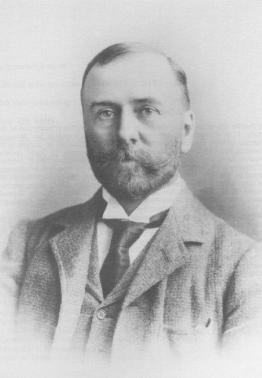
Downalong St Ives
By Sandra Pritchard
In the middle-ages, St Ives emerged as a fishing and trading port which led to the town developing around the wharf and harbour area. This produced a labyrinth of small narrow cobbled streets that later, when the town had spread, became known as 'Downalong'. Was the fine, tall, carved, Celtic lantern cross, now in the churchyard, a remnant from the church that once stood on Porthminster sands? Perhaps they dragged it across the dunes and over the warren to place it at the outfall of the Stennack stream, where they were to start building their new church in 1410.
As the town grew it faced famine, plague and civil war but it survived and flourished. The fleet grew and the herrings came every season. Every part of the fish was used and everyone in the town took part in the silver harvest of the sea.
The pilchards are come, and hevva is heard
And the town from the top to the bottom is stirred
Anxious faces are hurrying in every direction
To take a fine shoal they have no objection
The women now gathered before the White Hart,
Their hopes and their fears to each other impart
"What stem have you got?"...." A first to the lea"
"And look! Our men are now going to sea"
We see the huer with bushes in hand
Upon the white rock he now takes his stand
While "Right off", " Win tow boat"
"Hurray" and "Cowl rooze"
Are signals no seiner will ever refuse.
Alas the cry of “Hevva,hevva” is heard no more in the streets of St Ives

Edward Hain 1851-1917
The Hain family, who donated the land above Porthminster Point, were then living at Treloyan Manor, a house Edward Hain had built at the top of the hill near Tregenna Castle. He was descended from a very old local family of ship-masters and sailors and his shipping company sent ships far and wide overseas. They became a very wealthy family and owned large chunks of land and property known as the Porthia Estate. This included parts of Hellesvean, Hellesveor, Cold Harbour, Beagletodn, Skillywadden, Amalveor and Amalwhidden and much else in Towednack, Zennor and St Ives.
St
Ives “Booke of Recorde” dated 1573 mentions a payment of 1s 6d by Harrie
Hayne to the Corporation “for bords”. The St Ives Parish Registers state
that a John Hain, “mariner,” married Susanna Warren on 27th December 1779.
This is the earliest record of the family’s seafaring connections.
To
quote from “A History of Treloyhan Manor” by Cyril Noall: -
“
In former times St Ives boasted quite a substantial fleet off little sailing
vessels – brigs, schooners, barquentines – which carried copper ore from the
adjacent mines to the smelters in Wales, brought in supplies of coal, wood and
slate and exported casks of local-caught cured pilchards to Italy. The Hains
were interested in sailing ships, both as masters and owners, from the second
quarter of the 19th century; before this they had been fishermen. In 1816 a
certain Edward Hain was the master and part owner of a little three-mast fishing
lugger, “Dasher” built at St
Ives in that same year. In 1832, the same Edward Hain and his son -Edward Hain
the Younger- became, together with Richard Paynter, joint owners of the
“Camilla” a 114 ton schooner built at Stonehouse in 1825.”
Subsequently,
the family acquired other sailing vessels – “Mystery”- “Bohemian Girl”
- “Glynn”- “Margaret Hain” & “Arethusa”. The architect of this
fleet was Capt. Edward Hain (1829 – 1899), the third member of the family to
bear that name.
Cyril
Noall continues: -
“
Capt. Hain was a born sailor, one of the old school, who went to sea in command
of one of his own vessels at the age of 18. Under his guidance the small Hain
line grew to a position of moderate strength and prosperity and a number of
local people were induced to take up shares in his enterprise. There was
nothing, however, in the 1850’s and 60’s to distinguish it from a number of
similar fleets operated by other St Ives families, such as the Mollards, Shorts
and Mortons; and it is as certain as anything can be, that it would never have
emerged from this state of comparative obscurity but for the remarkable business
ability and organising genius of Capt. Hain’s son, the builder of Treloyhan
Manor ”.
Edward Hain IV, later to become Sir Edward, was born at St Ives in December 1851. He received his education at Mr James Rowe’s school, above Academy Steps in Fore Street. He was later sent to London to acquire experience of business methods by working for a time in a tea-merchants office. This translation from the quite little fishing town of St Ives to the greatest commercial centre in the world had a great effect on the young Edward. On his return to St Ives he presented his father with an ultimatum. He could see no future in continuing to run a line of little sailing vessels and if his father was not prepared to switch to steamships, he would leave the family business altogether and seek a career elsewhere. Capt. Hain heard this with regret. He loved his little schooners as if they were his children but he acceded to young Edward’s demands
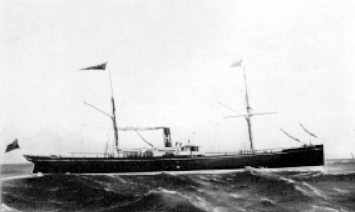
SS Trewidden
first ship built by Readhead for Hain1878
Messrs. John Readhead and Sons built the first Hain steamship at South Shields, Co. Durham in 1878. It was named ‘Trewidden’, an iron-built 1,800-ton vessel, schooner-rigged, 240 feet long, and propelled by a screw. With her, began the tradition of naming all Hains’ ships with the prefix of TRE, meaning - farmstead or hamlet. One of them, built in 1882, was actually called Trelyon, a variant spelling of Treloyhan. Other vessels were to include:- Tregenna, Trevethoe, Trevarrack, Trevalgan, Tremeadow, Trevessa Trebartha and Treveal.
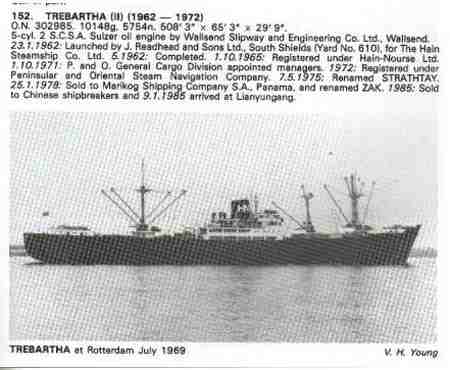
SS Trebartha built 1962-1972 Readhead last ship for Hain Steamship Co.
Under young Edwards’s management, the line developed rapidly and by 1907 the Hain fleet of merchant vessels numbered 34. As the fleet prospered so did the Hain family. In 1883 young Edward Hain became a member of St Ives Town Council and was elected Mayor some twelve months later, holding that office on six occasions. He became a J.P. and County Councilors and in 1900 was returned unopposed as Liberal Unionist MP. for the St Ives Division. However, he retired from politics owing to the increasing demands made on his time by business affairs in 1906. In 1910 he was dubbed a knight and a year later he was given the Freedom of St Ives
The typical success story of Sir Edwards’s public career was scarred, however by deep personal tragedy. His elder daughter Grace had died whilst at school in 1898 and in November 1915, their only son, Capt. Edward Hain was killed in action in Gallipoli. during the Dardanelle's campaign. He had been serving as a captain with the Cornish Squadron of the Royal 1st Devon Yeomanry. The shock possibly contributed to Sir Edward’s own death some two years later in 1917 at the age of 65. Only a few months after his passing the Hain Shipping line was purchased by the P & O and British India Steam Navigation Companies at a total cost of nearly £4,000,000. Hain Steamship Company continued as a separate operation within P&O. His widow lived on at Treloyhan until 1928 when most of the property was sold off. Sir Edward had hoped to hand on the business to his son at the end of the war and had dreamed of founding a new local dynasty to rival that of the earlier great families of Stephens, Praed and Tyringham – It was not to be
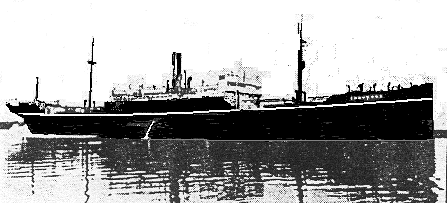
SS Trevessa sunk 3 June 1923 Indian Ocean

On
3
June 1923, the Hain
Line steamer "Trevessa”, loaded with zinc concentrates and on
route from Fremantle to Durban, sank very quickly in the Indian Ocean during a
violent storm. The 44-crew members scrambled into two lifeboats, some with
very little clothes on, and the Captain, Cecil Foster, decided to endeavor to
make for Mauritius some 2,000 miles away. With no compass and only enough
water for 7 pints per man, 550 biscuits and two cases of condensed milk, they
were immediately put on strict rations. The boats soon became separated
and with the soaring heat of the tropics some succumbed to drinking salt water
which caused them to become delirious and death followed quickly.
With
no wind the men had to row, which aggravated not only their swollen hands and
feet but also their bodies, which were suffering from extensive salt-water
boils. It was only by perfect discipline and obedience to the Captain's
orders that they stuck together and on the 23rd day one boat landed on the
island of Rodriguez and three days later the second boat landed at Bel-Ombre,
Mauritius and a total of 34 men survived.
On the second boat the engineer had fallen overboard during rough weather and
another crewman died two hours before land was sighted. The survivors in this
boat were so exhausted they had to be carried ashore, and the chief cook died
soon after arrival.
In Lelant church near the font is a stained class window of St Christopher
dedicated to the memory of Harry Sparks, who perished on 23rd June, 1923, after
the wreck of the S.S.Trevessa in the Indian Ocean.
A monument to the crew of "Trevessa" was erected on Bel-Ombre and on the anniversary of their landing on Mauritius "Trevessa Day" was celebrated which is now become "The Seafarers Day"
The
book is “THE LOSS OF THE TREVESSA”. Written by Cecil
Foster
First published 1924, Martin Hopkinson
& Co, London
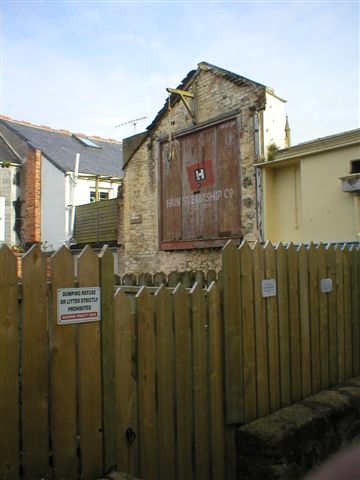
A fire destroyed this loft some years ago. All that remains is a brick wall, the hoist gallows & the flag of the Hain Steamship Co. painted on the loading bay door
To reach the town of St Ives in the old days there were two choices. Either walk across the sands and up over the rocks at Pednolva, then with a mine engine-house on the top, or up the Primrose Valley to the Tregenna Lane and down over the hill by Talland. This road now ends in the steep steps just opposite the Catholic Church at the top of Skidden Hill.
There was no railway line nor any road from Treloyan down past the Terrace. Even when a road was built here it was private and there was only gated access to the houses . Just below what is now the Malakoff Gardens and Bus Station was all cliff side . When James Halls built his town house near here it was in the middle of a field!
The first building as you went down Skidden hill and into the main street of the town was 'Beggar's Roost', the local doss house for every "tramp, vagrant, mumper and lazy vagabond in the district"
Then came the Garrison which housed the Revenue Men and the Riding Officers. The stone on the lower right hand corner is inscribed R.N.G. 1713 with an anchor. This is believed to stand for Royal Naval Garrison (click on small photo above) and the stone was probably removed from an earlier building on the site. Later, when The Terrace became a public highway and it was difficult to make the sharp right turn down Skidden Hill both it and St Andrew's Street lost their importance. Traffic continued on down Tregenna Hill and through the Green Court, which later became the main road. This saw the beer shops and inns and business of any importance move location. The Customs Boathouse and offices moved to the Wharf and a modern Coastguard Station was built on the new road up to Treloyhan, high on the cliffs above Porthminster Beach.
Opposite the Old Customs House the lane leads to the Warren and Pednolva Point. It did not then go along the seafront towards the church and harbour. This walk was later built to accommodate the huge bulk tanks necessary for the town's drainage system, after the great floods in the late 1880's. It appeared to work until a year or two ago when the Stennack River again caused problems when the culverts got blocked after heavy rain.

At the end of St Andrew's Street is the Parish Church, believed to have commenced being built in 1410. Close by is the Market House and surrounding it in the past were many inns and hostelries. Today only one remains in the immediate vicinity " The Golden Lion" and the Market House is a souvenir shop. The main road then continued along Fore Street, as again the waterfront was only negotiable in short lengths from the upper street. At one point along its length Fore Street becomes "The "Cliff", once a very exposed and windy spot, with no buildings on the seaward side to obstruct a view of the harbour and all the ships in full sail in the bay.
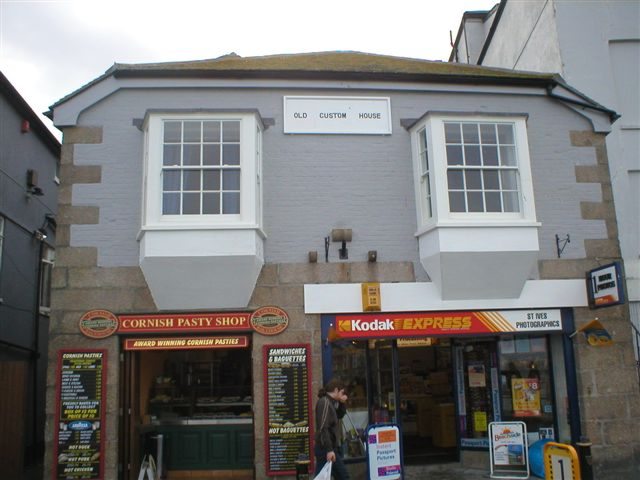
Old Customs House
Near here were steps that went down to the Customs House boathouse and the various boat building yards of the Paynter and Thomas families. Paynters leased this building to the Customs Authorities and next door was their boatyard, later Woolworth's Store. In the 1960's the family still operated their 'Seal Island' trips and the booking office was the Old Customs House. Dan Paynter would tout for customers along the Wharf road and he was a good teller of tales in the "Golden Lion " afterwards. His favourite tipple, when flush, was a 'Boilermaker' or a 'Rum and Shrub on special occasions. Otherwise he was content with a glass or mild and bitter. Today this pretty little building is divided into a "Cornish Pasty Shop" and a "Kodak Photo Express" but I think the Paynters still own it.
Along the wharves here were also basket makers, coopers and smoke houses and the street behind remained mainly residential. Food was bought either at the Market Hall or from itinerant sellers who came in from the farms in the countryside. Meager supplies, sold from the living rooms of the many widows who scratched a living this way, were also resorted to on occasion. Of course in those days there were also a surprising number of Ale Houses and Inns dotted along Fore Street and a collection of them further along where it joined up with Chy an Chy. Here were: The Ship, The Globe, The Ship Ashore, The White Hart and, the only one to survive to the present day, "The Sloop"
The main pilchard cellars were situated above Porthmeor Beach, now called Barnaloft Flats. The little houses led up from Fore Street along the edges of the lanes, towards the island and the exposed coastline that was on the north shore, hence the names of Norway Square and Nor'ard Lane.
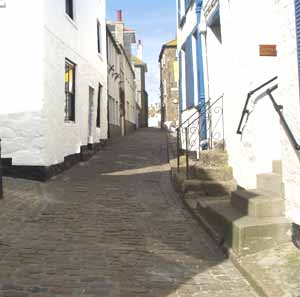

The living accommodation was usually up a set of stone steps, the space underneath being used to store either nets, sails and spars and the various accoutrements of the fishing trade. They were often called cellars, although not underground as people from 'up-country' would expect. The oldest remains in the Digey is in a little court where a stone arch marks the entrance to what was once the Hicks' family mansion.
Sometimes the houses were 3 or 4 story's high. Then there was room to store sails in the loft and, in the cellar, the obligatory barrel of train oil for cooking and lighting and another containing the salted 'pilchers' for the winter. These were ' put by' as a safety net against winters storms and starvation. Sometimes a family would be in business together in order to bulk up their own fish or to smoke or dry fish for sale, the hake being the most notoriously connected with St Ives.
The seine fishery was a business adventure that required huge amounts of cash investment and the season was short. The owners of these were the landed gentlemen or prosperous businessmen of the area who set up companies. They paid the huer and the seine and tuck boat crews; they paid for the salt to preserve the fish and the cellar women who laid them in baulk and they paid all the expenses of the coopers, who made the barrels to export the fish in. These workers negotiated a set price for their labour per hogshead for the season. If the season was bad no wages were paid. They caught, salted, packed and exported to the Mediterranean ports of Leghorn and Naples. The Company men owned the nets, the seine boats, the cellars and the ships. This was really factory fishing and eventually the price was paid - one day the pilchards came no more.
Other fishermen were more often in business on their own account and shared both boats, nets and hardship with their relatives, as was the accepted Cornish way.
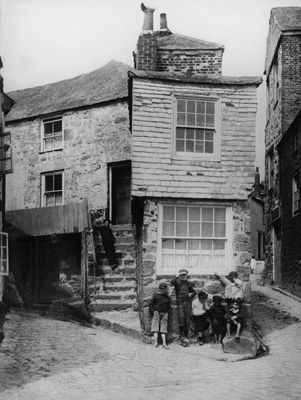
"Pudding Bag Lane - in one way and out the same"
This lane was next to "The Sloop" at the bottom of Dick's Hill, now know as Fish Street. It was said that there was a cupboard in this first house that children were forbidden to open 'on pain of death'. When the row was pulled down in the 1920's it was rumoured that the demolition gang had found a set of steps that led down to a tunnel that then went under the road and surfaced in one of the many cellars under the inn opposite.
Perhaps this was a bolt hole for the illicit stock of the landlady of "The Sloop"; a place to hide her secret stash away from the prying eyes of the Customs Men . If so the landlady of the Sloop failed to use it when there was a raid on the town by HM Customs in 1898.
Many in the town had been allowed to simply pay their fines for possessing smuggled goods, but two innkeepers of the town were brought before the bench.
Mrs Elizabeth Baragwanath was summoned in the St Ives Police Court "for a breach of Section 1876 by smuggling tobacco, and further with a breach of Section 6 of the Manufactured Tobacco Act 1863." The solicitor for HM Customs, one Mr Le Breton, said he understood that she had pleaded guilty to both charges and he was willing to drop the second charge, provided she paid treble the duty and value on the other summons. So Lizzie Baragwanath was fined £7 : 14s :3d.
The landlord of "White Hart Inn",William Elijah Benney, was similarly charged and was fined £1 : 9s : 3d for having 1.lb 8oz of uncustomed tobacco. My maths was never good but at a rough guess that means the landlady of "The Sloop" had about 7lb: 8oz of tobacco stashed away.
I should add at this point that the "White Hart Inn" was ALSO at the bottom of Dick's Hill and therefore ALSO opposite the entrance to Pudding Bag Lane, so the apocryphal 'secret tunnels' could ALSO have led to these cellars. Perhaps the tunnels had been abandoned long ago, due to this area flooding at very high tides. Perhaps neither landlord had any knowledge of their existence by this late date; leastways, neither innkeeper had made use of them.
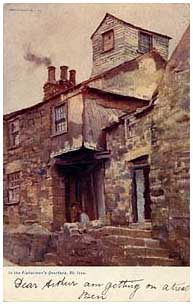
Postcard dated 1904 Photo dated 2004
This is the "Bretons' House" reputedly the oldest house in St Ives. It was built sometime in the early1500's as a summer lodging for the Breton fisherman, who spent a great part of that season fishing the waters around St Ives Bay. The Cornish then could well understand their Breton cousins. Some of them were to remain in Cornwall when Henry VIII fell out with the Pope circa 1534 and trade, and the easy passage of people between England and the other catholic countries, became more difficult.
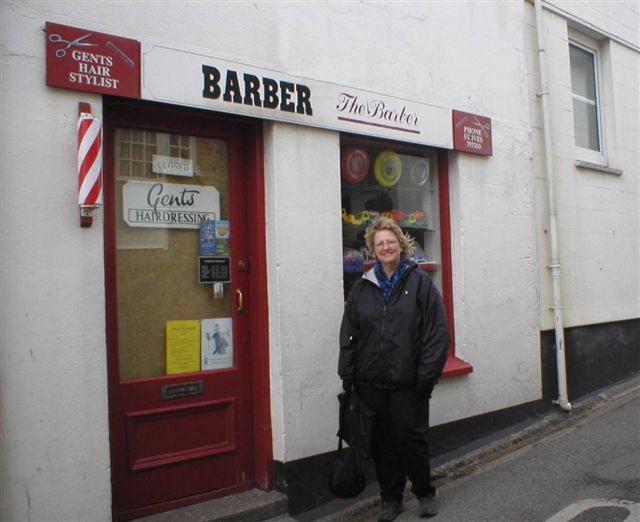
"Barber the Barber" was a great poet & songster His family had always been involved in the fishing but he turned to haircutting for a living. This is just a short way up Dick's Hill and on the corner of Back Road West. Jan came all the way from California to say Hi !.. ........... but he was closed!
One of his poems was Doble's Wall. It was put to music and song by the '"ol' boys" of the St Ives Minstrels, which included John Barber himself. Sometimes they would sing it on summer evenings sitting on the wall itself. It brought a lump to the throat I can tell you.
Here is a photo of the wall circa 1925.................
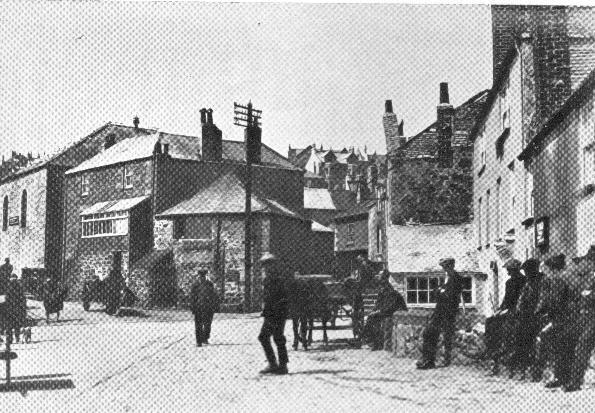
Once there were many fisherman, old and young, who would gather on the wharf. Today they are a dying breed. The Fishermen's Lodges are still there but, where once there were several now only three remain The Rose, The Shore Shelter and the Shamrock
Originally the first two were on the sands "Shore" shelter opened 12 Oct 1901 and "Rose" opened a week later on 19 Oct 1901. " Shamrock" lodge was opened on the same day as "Shore" shelter, on its present site in front of what was then the "White Hart". As the two on the beach became undermined arrangements were made to move them onto the Platt in front of the old Bible Christian Chapel. This was done in 1918 with a bequest f £300 in the will of Sir Edward Hain.
Other lodges at on time were:- the "One and All" [collapsed 1931] and "Bay View " behind Smeaton's pier [succumbed in 1970 after a storm ]
They were put there so that the seamen, sailors and fishermen could meet when the weather was too 'dirty' for them to go to sea or to work on their boats. They would be out from under the feet of their wives and be in good company. They were meant to be a distraction from the public houses and no drink was allowed over the threshold. Games like euchre, dominoes, cards and draughts were played. They were men only preserves and women rarely entered; children were tolerated on occasion.
The interiors were kept spick & span. Every Saturday the lockers and floors were scrubbed and sand on the floors was replaced with fresh from Porthmeor, the sand from the harbour not being good enough. A close look at the photos will reveal a vacuum cleaner or two and some carpet runners today. "Shamrock" Lodge is still intact but when I took the photo the furnishings appear to have been moved for safe keeping to "Shore" shelter and the lodge boarded up and locked. It has a high wall on the seaward side which has afforded it some protection over the years. This was built to ensure German tanks did not land here in the last war. I think they would have found the hills at Skidden, Tregenna and Barnoon a bit too steep for them though !
Shore shelter
The Rose
Before finishing this piece on "Downalong" I must mention the painter Alfred Wallis. St Ives claims him as a son but his family was from Sennen where he was born. He lived for a while in Gas Works Court, Penzance and was a basket maker at first. Although people say he must have gone to sea to have had all the knowledge about ships and rigging etc it must be remembered that he spent most of his life beside the water. Perhaps he was better able to observe ships than if he were on them. The plaque denoting the place where he lived is on a house in one of the back streets but, when he first married a woman much older than himself, he moved from Penzance to St Ives and lived in a house on the wharf. From there he carried on the trade of a dealer in marine supplies He was charged a couple of times for receiving stolen goods and must have "sailed very close to the wind", figuratively speaking.
It was not until old age that he began to paint on old scraps of fruit boxes and cardboard.. Most of his paintings ended up being burnt as " a passel pf old traade" -the Cornish term for rubbish. Sadly he ended his days in Madron Workhouse but his friends in St Ives clubbed together and paid for him to be buried in Barnoon Cemetery, thus avoiding the ignominy of a paupers, unmarked grave
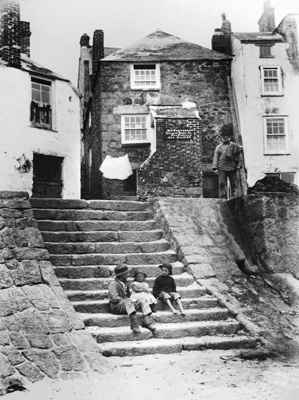
Here are a couple of pictures of Alfred Wallis' house on the wharf which I think was situated not far from where the Fishermen's Coop is today.

The lady in the picture is Mrs Wallis. The view from the front porch would have been of all the boats drawn up on the sand in the harbour.
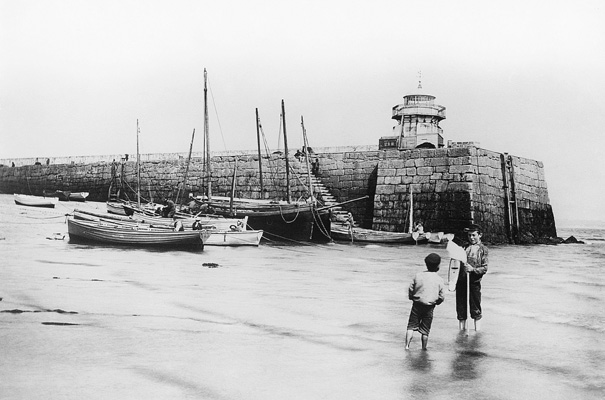
The pier would have ended at Smeaton's Lighthouse before 1888. It was later extended to its present length to accommodate the boats bringing their coal from Wales to feed the newly built Gas Works behind Porthmeor Beach, now the site of the St Ives Tate.
And so the little wander around the main thoroughfares of St Ives past comes to an end.
There are many more corners that conceal little gems of history but we will save that for another day. Today it is hard to walk in comfort around the little back streets with all the cars wishing to get where cars were never meant to go and vans delivering supplies to all the cafes and restaurants that never used to be. Oh!, that someone would have the nerve to ban their use altogether and provide a public electric shuttle to quietly travel around the little streets, delivering supplies and offering a lift now and then to those of us who are not too good on our old pins !!.
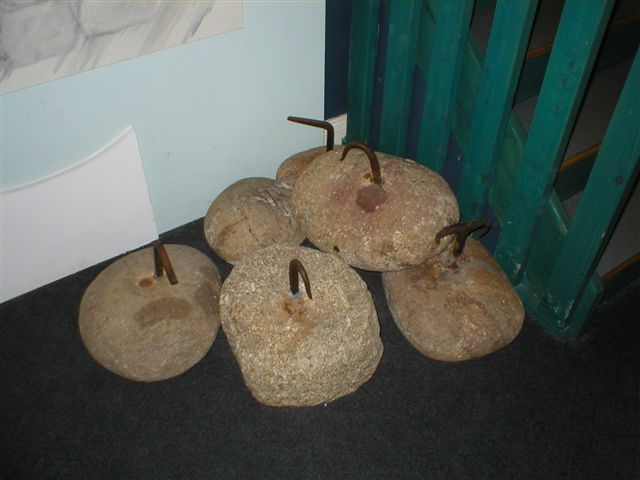
Pilchard Pressing Stones
THE END